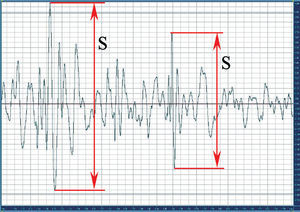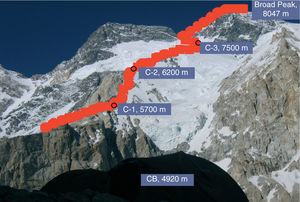To the Editor:
The interest in adventure sports, particularly high-altitude hiking and climbing, is on the rise and there are hundreds of thousands of fans worldwide. As a result, there is also considerable interest from the public health and economic points of view in the diagnosis of cardiopulmonary complications inherent to these sports, which mainly occur secondary to pulmonary hypertension (PHT) caused by hypoxic vasoconstriction of the lung bases; high-altitude pulmonary edema (HAPE) is one of the most serious of these complications. However, the condition presents huge difficulties due to the need for immediate medical care and the lack of hospital resources in a harsh environment.1-5
We describe a case of clinical and phonocardiographic follow-up via satellite of a mountain climber during the UMU 2005 climb to Broad Peak summit, at an altitude 8047 m, in the Karakorum mountain range. An electronic stethoscope was used to record the phonocardiographic signals and the pulse oximetry of the climber and the data were sent to the medical and research team at the Universidad de Murcia (University of Murcia) by satellite for analysis and comparison to baseline records, using a web-based interface developed specifically for this research project.6,7 Likewise, specifically developed custom software was used for signal acquisition via a laptop computer and personal digital assistant (PDA).6,8 The signals recorded with the analog and digital recorders were later uploaded to a laptop equipped with a modem and a satellite cell phone, in the first case as an audio signal and in the second, directly as a file.
For the statistical analysis of the data, a correlation study between the S2/S1 ratio and the SaO2 values was done with Pearson's correlation coefficient for 10 paired samples, using the average values of the amplitudes of the first and second sound in each recording for the S2/S1 ratio, based on a total of 10 records.
Analysis in the Time Domain
The normalized amplitudes for each record were first analyzed by measuring all maximum peak-to-peak values for the first sound (S1) and second sound (S2), as shown in Figure 1, as well as the ratio between the 2 values (hereinafter, S2/S1) for the entire recorded time. The mean value obtained for each sound was used as representative data of each record. Figure 2 shows a photograph of the mountain and the location of the various camps where recordings were obtained. A linear regression analysis between the S2/S1 values and the SaO2 value confirmed that the 2 parameters are closely related, a conclusion also drawn from the high correlation index obtained (0.92). A scatter plot of these data and the calculated regression line is shown in Figure 3. The negative sign results from the evolution of these parameters in opposite directions, ie, an increased S2/S1 ratio becomes a decreased SaO2 value.
Figure 1. Peak-to-peak measurements of the first and second sounds of a cycle.
Figure 2. Camp location on Broad Peak climbing path.
Figure 3. Variation in SaO2 value versus S2/S1 ratio.
Despite the inherent limitations of this initial descriptive study, we believe that the changes in the S2/S1 ratio we have defined and the ratio observed with respect to the oximetry data as a potential marker of the degree of high-altitude acclimatization could be somewhat indicative of PHT for a specific altitude and physical exercise in the normal subject monitored. These parameters may also be useful in climbers with more exacerbated hemodynamic changes which could ultimately manifest as HAPE.
We found no references in the literature of wireless phonocardiographic transmission in high-altitude mountain climbing. We firmly believe that further advances in the filtering system used for heart sounds, particularly those associated with cardiac auscultation phenomena, that we are currently developing may be useful for diagnostic and therapeutic purposes and could be tested shortly in upcoming high-altitude climbs by the members of this group.
Source of funding
This work was partially subsidized by the Universidad de Murcia and the Ministerio de Ciencia y Tecnología (Ministry of Science and Technology) through the research project "Remote Phonocardiogram Monitoring Using an Intelligent Signal Interpretation System" under reference number TIC2003-09400-C04-02.





